Charts of the Week
Current economic trends from 12 to 16 July 2021: traffic of electronically tolled vehicles, electricity consumption, electricity consumption by consumption group, fiscal verification of invoices and other charts
Freight traffic on Slovenian motorways increased significantly in early July compared to a year earlier. Electricity consumption was also slightly higher, mainly due to the base effect, as activity was still low last year after the first wave of the epidemic. The volume of traffic is close to comparable 2019 levels, and the gap in electricity consumption is narrowing due to the gradual increase of activity in the tourism sector. Coupled with the low base, this is also impacting year-on-year sales growth in most tourism-related sectors, while sales in the arts, entertainment and recreation sector was also up year-on-year in early July. Due to the continued restrictions on certain business activities in this group of services, sales in early July was still significantly lower than in the same period of 2019. Employment in these activities was still lower in May than a year earlier, although the overall labour market situation is improving due to the gradual easing of measures and is approaching pre-crisis levels. The highest year-on-year employment growth in May was seen in human health, social work and construction. In May, activity in construction fell in all segments on a monthly and annual basis.
Traffic of electronically tolled vehicles on Slovenian motorways, July 2021
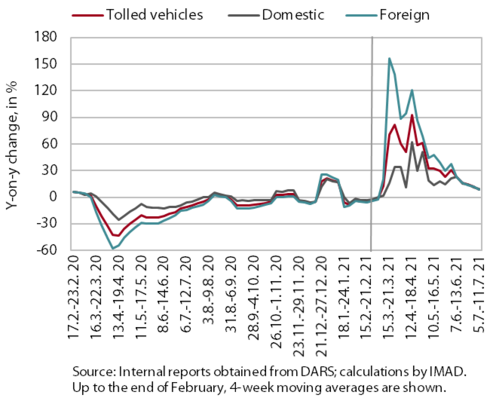
In the second week of July, freight traffic on Slovenian motorways was 9% higher year-on-year and the same as in the same week of 2019. The significant year-on-year increase is still mainly due to the low base, namely lower traffic volume in the same period last year after the first wave of the epidemic. In the second week of July, freight traffic volume was similar to previous week and the same week in 2019 (with a slightly higher proportion of domestic vehicles) due to reduced traffic flow on the motorways as a result of the summer holidays.
Electricity consumption, July 2021
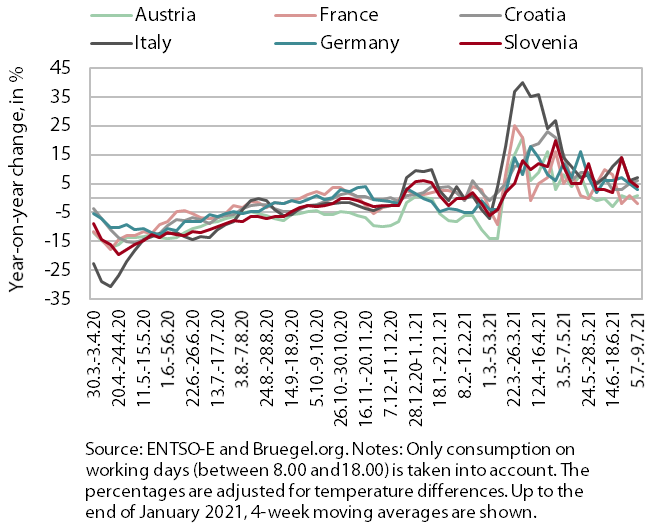
In the week between 5 and 9 July, electricity consumption was 4% higher year-on-year, but 3% lower than the same week of 2019. The reason for the higher year-on-year consumption is mainly due to the low base of last year, and the gap compared to the same week in 2019 narrowed further, mainly due to higher activity in the tourism sector. Mainly owing to the base effect, higher year-on-year consumption was also recorded in most of Slovenia’s main trading partners (1% in Austria, 3% in Germany and around 7% in Italy and Croatia), while it was 2% lower in France. Compared to the same week of 2019, most partner countries recorded lower consumption (Austria by 1%, Croatia by 3%, France and Italy by 6%), while consumption in Germany remained the same.
Electricity consumption by consumption group, June 2021
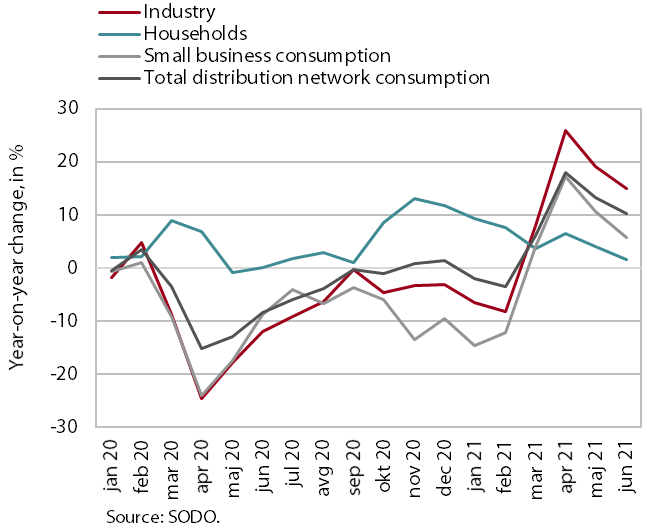
In June, industrial electricity consumption reached the level of the same period of 2019 for the first time since the epidemic began, and small business electricity consumption lagged behind 2019 levels, although the gap with the previous month narrowed. In June, industrial electricity consumption was up 15% and small business electricity consumption was up 5.7% year-on-year. The main reason for this is last year's low base, when electricity consumption was significantly lower at the end of the first wave of the epidemic due to containment measures. Household consumption was also higher year-on-year (by 1.7%). Compared to June 2019, industrial electricity consumption increased by 1.2% (after decreasing by 2.1% in May), household consumption decreased by 1.7% and small business electricity consumption decreased by 3.6% (by 8.7% in May).
Fiscal verification of invoices, July 2021
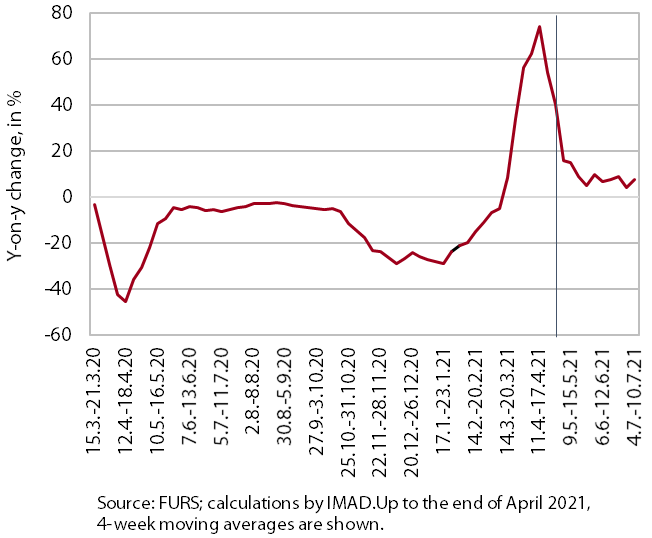
According to data on the fiscal verification of invoices, sales between 27 June and 10 July was 6% higher year-on-year and 4% lower than in the same period of 2019. The positive trend in trade continued, with sales in wholesale and retail trade increasing by around 4% year-on-year and compared to 2019. In most tourism-related sectors (accommodation, gambling and betting, travel agencies), as well as arts, entertainment and recreation, sales growth was even higher year-on-year due to the low base. As a result of the continued restrictions on certain business activities in this service group, sales was between 14% (accommodation) and 79% (travel agencies) lower than in the same period of 2019. With a sharp increase last year, personal services sales was lower year-on-year but higher than the same period of 2019.
Labour market, May – June 2021
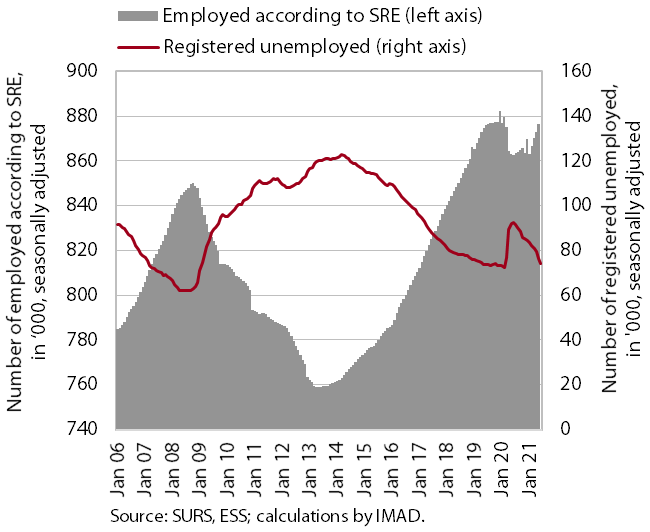
The sharp decline in unemployment continued in June due to the gradual easing of containment measures and economic recovery. At the end of June, 71,094 people were unemployed, 5.4% fewer than at the end of May and 20.5% fewer than a year earlier. Compared with the end of June 2019, the number of unemployed was only 0.5% higher. The number of employed persons was 1.6% higher in May than in the same month last year, mainly due to the base effect (sharp decline in May 2020). The year-on-year decline in employment was again the largest in accommodation and food service activities and arts, entertainment and recreation, the sectors most affected by the containment measures, while the largest increase in employment was recorded in human health and social work. Year-on-year employment growth in construction was also above average in May.
Construction, May 2021
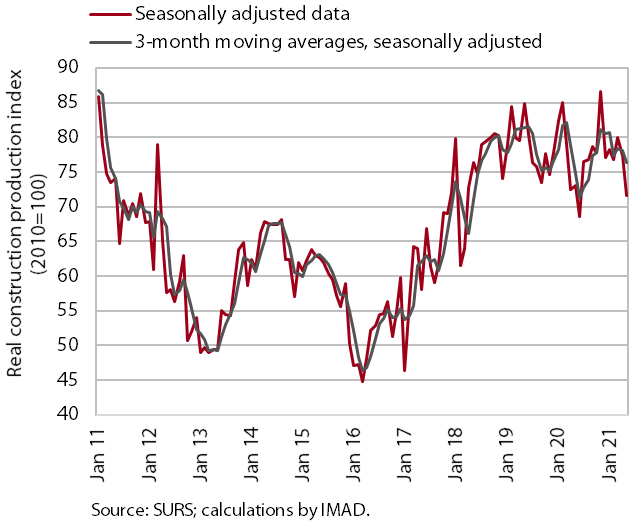
In May, activity dropped in all construction segments. The value of construction output fell by 7.5% and was 2.6% lower than a year earlier. In the first five months of this year, overall construction activity was at a similar level to last year. However, it strengthened in residential building construction, was almost unchanged in civil-engineering and specialised construction, and was much lower in residential building construction. Data on the number of contracts suggest that activity in non-residential construction will remain relatively low, while other segments, particularly civil-engineering and specialised construction activities, are likely to perform better.
Construction prices have risen significantly under the pressure of rising commodity prices and labour shortages. The implicit deflator of the value of completed construction work used to measure construction prices was 6% in May, the highest level since 2005.
The balance of payments, May 2021
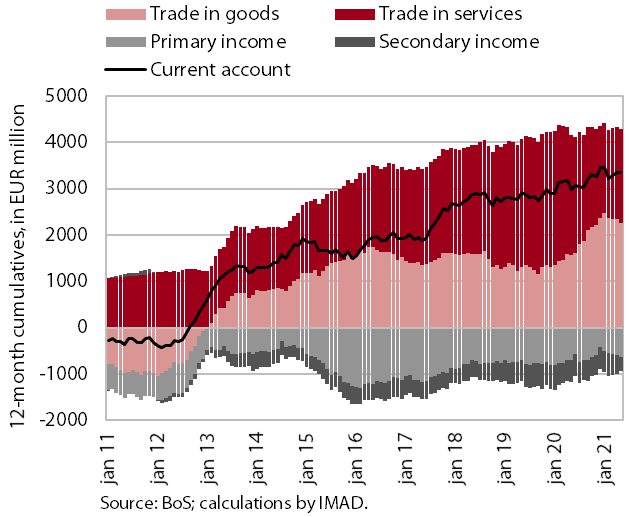
The current account surplus in the 12 months to May remained high, totalling EUR 3.3 billion (6.9% of estimated GDP). The year-on-year higher surplus in current transactions was mainly attributable to a higher trade surplus as export growth outpaced import growth. The terms of trade improved year-on-year last year and have not yet affected the annual surplus in trade in goods given the rise in energy prices this year. The year-on-year increase in the current account surplus was also due to lower net outflows of primary and secondary income. Net outflows of primary income were down year-on-year owing to lower net outflow of income from equity and debt and higher subsidies from the EU budget for the agricultural and fisheries policy. Net outflows of secondary income decreased mainly due to higher social contributions from the EU budget. The surplus in services trade decreased mainly due to a decline in the surplus in the travel segment and partly due to a lower surplus in transportation services.
Road and rail freight transport – Q1 2021
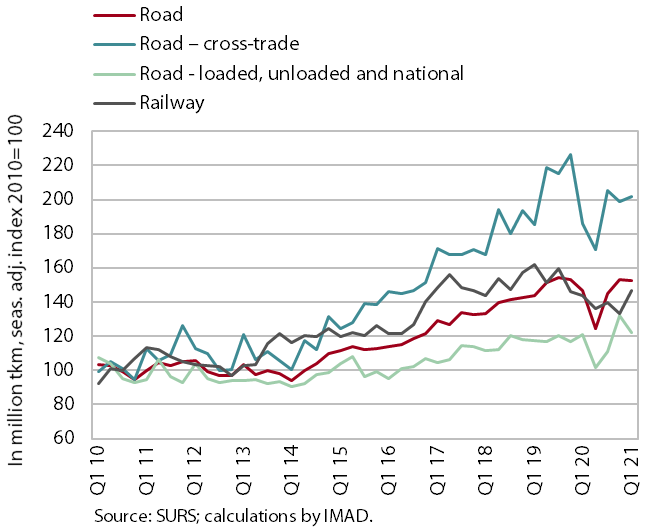
In the first quarter of 2021, the road freight volumes were a few percent higher than in the same period last year and the year before, while the volume of rail transport rebounded after a long period of decline. Due to the strict containment measures in most European countries, the volume of road transport carried out by Slovenian road freight operators abroad decreased significantly in the first half of last year. With the easing of measures, it increased in the first quarter and was up 9% year-on-year. The volume of road transport carried out at least in part on the territory of Slovenia (exports, imports and domestic transport combined) is also slowly recovering after the decline in the first wave of the epidemic (higher by 1% year-on-year in the first quarter). Rail freight transport, which had been declining even before the epidemic, increased significantly again in the first quarter (+2% year-on-year).
